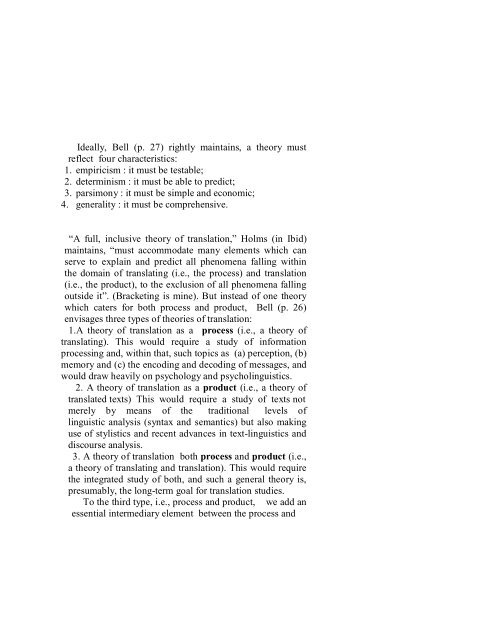424_2061_A.B.
424_2061_A.B.
424_2061_A.B.
- No tags were found...
You also want an ePaper? Increase the reach of your titles
YUMPU automatically turns print PDFs into web optimized ePapers that Google loves.
Ideally, Bell (p. 27) rightly maintains, a theory mustreflect four characteristics:1. empiricism : it must be testable;2. determinism : it must be able to predict;3. parsimony : it must be simple and economic;4. generality : it must be comprehensive.“A full, inclusive theory of translation,” Holms (in Ibid)maintains, “must accommodate many elements which canserve to explain and predict all phenomena falling withinthe domain of translating (i.e., the process) and translation(i.e., the product), to the exclusion of all phenomena fallingoutside it”. (Bracketing is mine). But instead of one theorywhich caters for both process and product, Bell (p. 26)envisages three types of theories of translation:1.A theory of translation as a process (i.e., a theory oftranslating). This would require a study of informationprocessing and, within that, such topics as (a) perception, (b)memory and (c) the encoding and decoding of messages, andwould draw heavily on psychology and psycholinguistics.2. A theory of translation as a product (i.e., a theory oftranslated texts) This would require a study of texts notmerely by means of the traditional levels oflinguistic analysis (syntax and semantics) but also makinguse of stylistics and recent advances in text-linguistics anddiscourse analysis.3. A theory of translation both process and product (i.e.,a theory of translating and translation). This would requirethe integrated study of both, and such a general theory is,presumably, the long-term goal for translation studies.To the third type, i.e., process and product, we add anessential intermediary element between the process and49
















